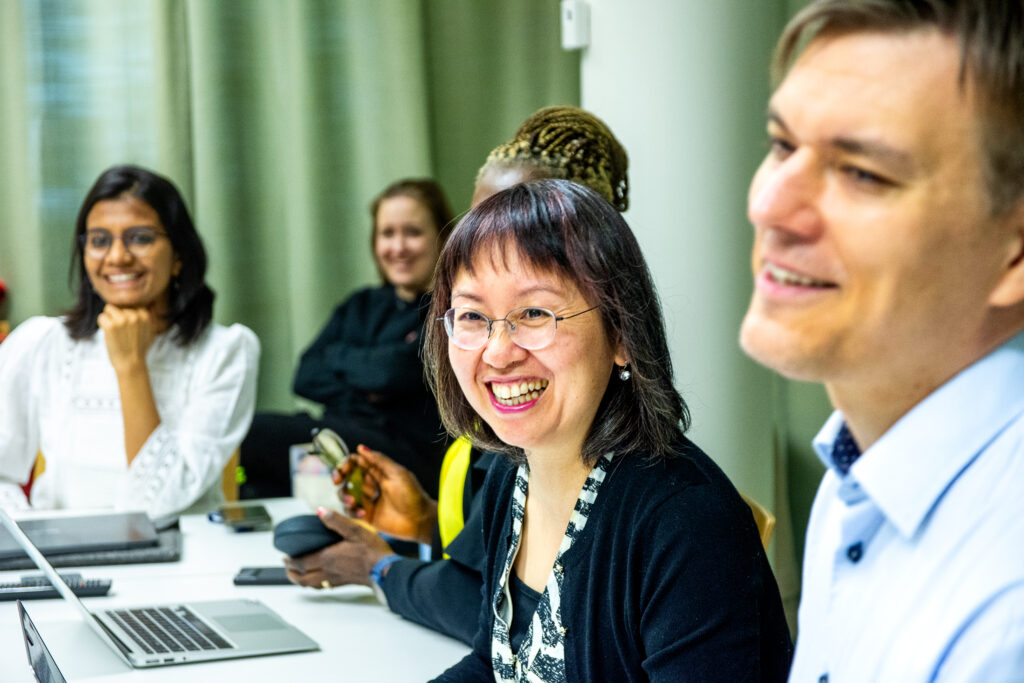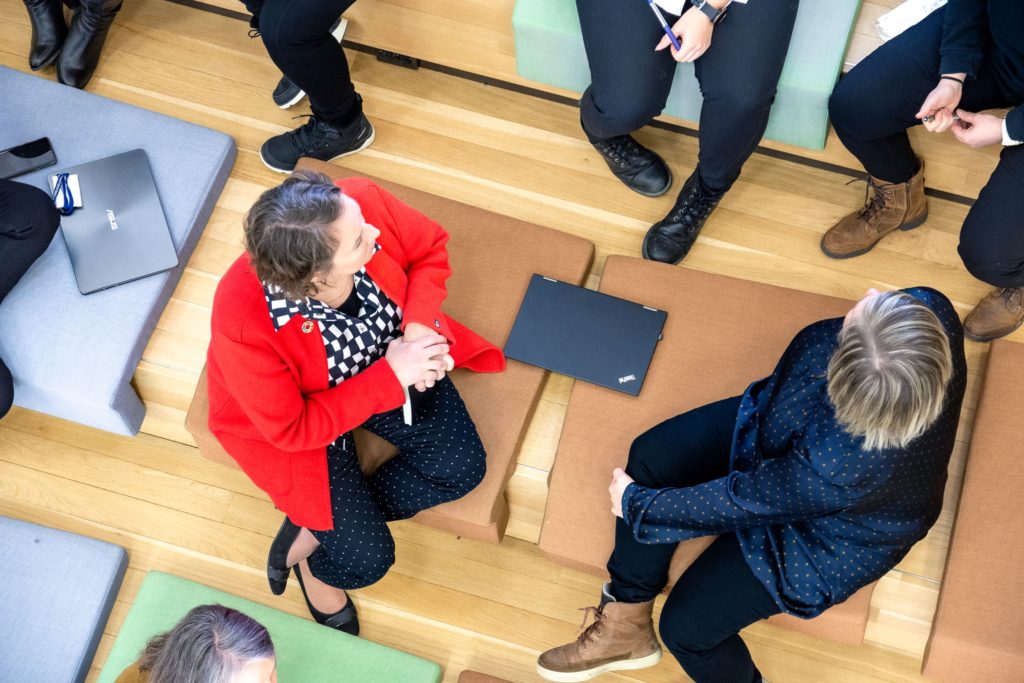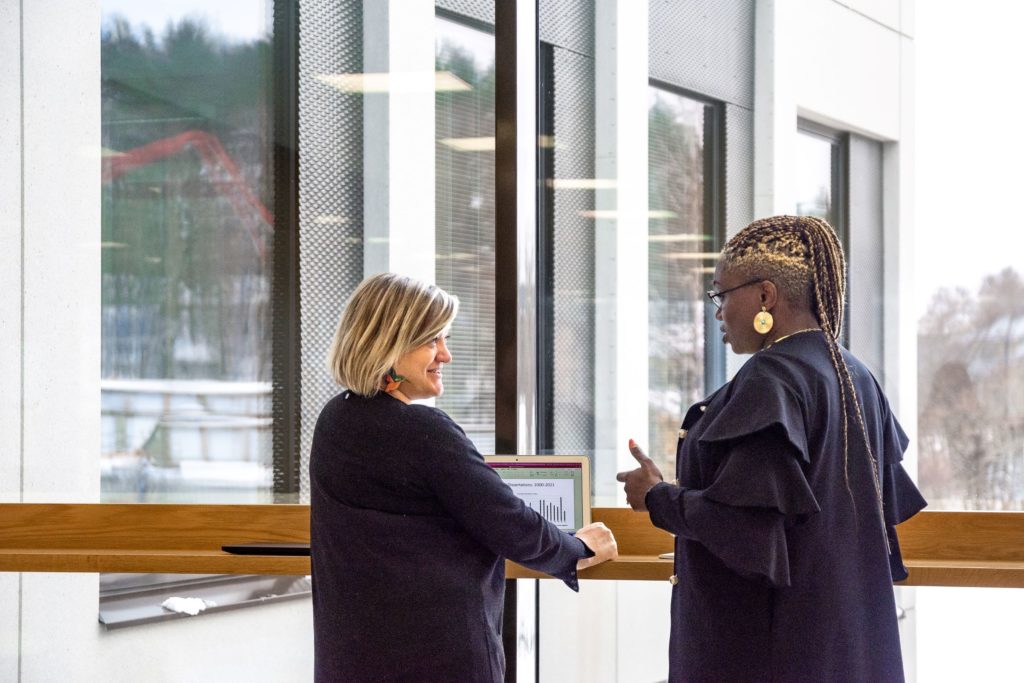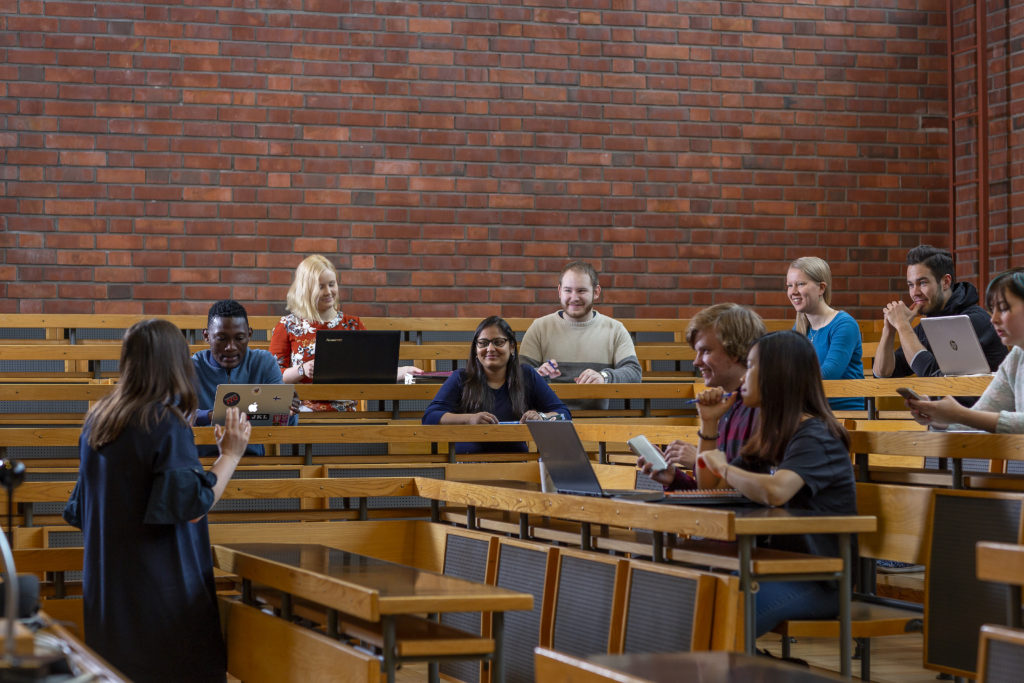Lessons Learnt
Almost a year has passed since we started the GINTL Lessons Learnt process – a series of collaborative reflection exercises to figure out “what did we as Finnish higher education institutions learn from the past 3 years of education development activities that we did with a variety of partners in Finland and around the world?”
The outcomes of that process are now available in a draft format. We would appreciate your comments by 13 November 2024 (kindly send to veera.i.virmasalo@jyu.fi).
Topics
You can download the drafts as PDF files or read them as inline text below.
- Future collaboration – Networked action between Finnish HEIs and their partners in global education development
- Higher education internationalisation in educational sciences and related fields ‒ Experiences from Finland
- The importance of North–South partnerships in educational sciences for addressing the global education crises
- Doing right with international students in educational sciences degree programmes – Experiences from Finland

GINTL insights on future collaboration – Networked action between Finnish HEIs and their partners in global education development
- Networked action between 20 Finnish HEIs was piloted in 2021–2024.
- Multi-HEI collaboration is key for opportunities in global education development.
- Main benefits: mutual understanding, pooling of expertise, quality partnerships.
The pilot network
GINTL was designed at a request of the Finnish Ministry of Education and Culture to support the internationalisation of Finnish higher education institutions (HEIs). The network activities were funded by the participating Finnish HEIs, from their strategic funding for internationalisation.
Each HEI retained full control of their GINTL funds and activities. The coordination team encouraged collaboration for sharing knowledge and experiences, worked to facilitate networking, and enhancing capacities around global education development. They also ensured HEIs were represented in multi-stakeholder platforms, such as the Koulutus kehityvissä maissa working group, the China Round Table at the Ministry of Education and Culture, and the Education Finland collaboration with India’s NCERT. (For details, see Annex to the Insights.)
Benefits and potential
Internationalisation at home
- Community of practice for global education-minded professionals scattered in different HEIs.
- Cost-effective knowledge creation, sharing of immaterial resources and shared platforms (website, seminars, short courses).
- Future potential: Joint student events to support intellectual exchange and learning. Opportunities for students to engage with global education issues beyond international educational sciences master’s programmes. Harness the experiences and diverse perspectives of international and visiting staff to improve teaching and research at the HEIs and support smooth living in the Finnish society.
Partnerships
- Connecting diverse realities.
- Research on partnerships builds a better understanding of the partnership processes; focus on ethical partnerships and decolonisation.
- Concrete collaboration cases (see Annex to the Insights).
- Future potential: Sustained partnerships yield successful funding applications when partners understand well the different needs of and possibilities within their institutions and know their way of working. These coalitions can partner with other successful coalitions, thus strengthening existing networks. Research-based education development takes time to make change, only sustained partnerships will lead to change.
Collaboration with other stakeholders
- Identification of expertise and resources required for research projects and capacity building tenders. No one HEI has all the expertise.
- Presenting higher education institutions’ expertise of and opportunities for teaching / research collaboration in global education development to other stakeholders in Finnish education development and commercial education endeavours scene.
- Future potential: Multistakeholder collaboration requires concerted efforts to be mutually beneficial for all partners. Like in all partnerships, these collaborations require time to flourish. Solid collaboration strengthens HEI capacity in multistakeholder collaboration in such a way, which would allow access to international large-scale projects.
Why continue collaboration
- Finnish HEIs are all too small to engage in large-scale collaborative projects.
- If Finnish HEIs want to be among the global forerunners in education development, they have to work together. Overlapping and scattered initiatives may be beneficial for individual academics or simple institutional goals, but they tend to produce less longstanding impact.
- Much expertise, resources, and knowledge are wasted on competing for limited resources instead of collaborating for mutual benefit.
Suggestions for the future
Potential focus
- Developing education (teaching, learning and teacher education) and sharing a common goal and a means of working for mutually beneficial purpose.
- Building on collaboration and sharing between higher education institutions and individuals, encouraging multistakeholder engagement. A network offers a structure and space for collaboration.
Potential activities
- Promoting a discussion around the need of educating experts for international education development in collaboration with international master’s programmes in education.
- Identification of opportunities for collaboration in research and teaching through building strategic partnerships across and within regions and countries.
- Encouraging internationalisation within teaching, especially in the field of education, and sharing knowledge of and learnings from international collaboration (see Huusko & Nurkka, 2024).
- Dialogues with different stakeholders on global education development.
- Presenting higher education perspectives in international education collaboration.
- Promoting global education development topics in Finnish higher education.
Other remarks relevant for future collaboration
Regarding format
- Coordination is needed to move things forward.
- In addition to moving things forward, coordination or a focal point is also needed to provide an easy access point to Finnish higher education institutions for other stakeholders in global education development.
Things to avoid
- A network should not determine too narrowly its functions. A certain fuzziness is important for easy participation.
Open questions
- Who would coordinate activities and actions related to global education development if no one institution is named for it?
- What would be the minimum and what would be the optimal in the coordination of academic partnerships for global education development that will ensure the continuation of what has been achieved?
- Coordination is often perceived to be a burden, a duty beyond the ‘business as usual’. What are the necessary incentives for institutions to take up coordination?
References
Huusko & Nurkka, 2024, Kansainvälisyysosaamisen kehittäminen korkeakoulutuksessa. Kansallinen koulutuksen arviointikeskus (KARVI)
Väyrynen, S., Virmasalo, V., Manyando, M. & Kangasvieri, T. (2024). Suomalaisen opettajankoulutuksen yhteistyö globaalin etelän toimijoiden kanssa – mitä opimme GINTL-verkostoa koordinoidessamme? eLIKSIIRI, 22.5.2024.

GINTL insights on higher education internationalisation in educational sciences and related fields – Experiences from Finland
- Many different expectations for internationalisation exist within and outside HEIs.
- Not all expectations are a good fit for the HEI core duties.
- We recommend continuous dialogue to clarify roles, interests and limitations.
Multiple expectations
The internationalisation of higher education institutions (HEIs) in educational sciences, teacher education, and related fields is driven by several different, and sometimes conflicting, expectations. The expectations observed in GINTL work included:
Finnish government & HEI management
- Financial sustainability of HEIs (joint study programmes, fees, top research and talent).
- Boost for Finland’s educational export industry (visibility, references, networks, deals).
- Finnish contribution to global challenges (“develop solutions to global education crisis”).
Academic staff in Finnish HEIs
- Connecting diverse realities.
- Building ethical partnerships with mutual exchanges and benefits.
- Joint research and projects (mainly in partner countries) and access to research funding.
- Opportunities for “doing good”, traveling, interaction, personal and professional growth.
- Opportunities for students.
- Globally minded students and staff.
Partners in India/China/Africa
- As previous, with additions:
- Funding for research and impactful interventions in own country.
- Opportunities for schoolteachers, officials and researchers to visit Finnish schools.
- Opportunities to share own research and expertise with education stakeholders in Finland.
- Sourcing experts from Finnish HEIs to advise in educational reforms and to build capacity at school level.
Expectations vs. HEI duties
For sustainability, internationalisation activities should align with HEI’s core duties: research, education, and societal impact. There’s been little discussion on how international these duties should be.
Apart from the now-ending massive investment in GINTL and other global network pilots, the government’s funding model for HEIs offers limited incentives for international collaborations, except those leading to publications, attracting fee-paying international students, or securing external funding.
Individual HEIs may prioritize internationalization for funding, but many domestic issues compete for these resources. Even when internationalization is prioritized, relevant fields for global education development may still be overlooked.
Barriers
Several barriers limit Finnish HEIs’ ability to meet external expectations in global education development:
- The foremost responsibility of HEIs is to the students in their degree programmes.
- Staff time is tied up in teaching and research, with most work plans set for the full academic year at a time.
- International capacity building projects often mean less time for publishing, crucial for academic careers.
- Most external funding requires self-funding, typically as a coordinator’s working time, which is hard to secure during austerity.
- Requests from state organisations in partner countries often focus on (school) visits, short courses, or tailored content, which are costly and don’t contribute to HEIs’ core duties, falling instead under education export companies.
- Compared with many other academic fields in Finland, educational sciences and teacher training face relatively greater challenges in terms of internationalisation (see GINTL Insights on global education crises and international students).
For consideration
Finnish HEIs and their partners
- It is important for all parties to clarify their possible roles and understand each other’s contexts. For example, what domestic constraints limit their actions and capabilities? What benefits them, and what does not? What is the scale and type of resources they command or have access to? What is already being done by other actors?
- As higher education institutions, our role differs from that of development organisations such as NGOs or the UN. Our collaborations should leverage our strengths, focusing on enhancing our capabilities in research and education for the best of education in our societies.
Finnish government
- See the last point above – the most fruitful international role for HEIs is in collaboration with peers in partner countries. If the government wishes for HEIs to engage in education development or export support that does not directly benefit their core duties, it is essential to provide additional resources to cover the costs.
- HEI engagement in global education development cannot be driven by the agenda of “creating solutions”. Educational sciences research requires a much deeper contextual understanding than research in many other fields (see the GINTL Insight on educational crises).
- In the global South, educational sciences and teacher training often struggle to access domestic funding. HEI collaborations therefore play an important role in this area.
- Include a research component in government-funded capacity development projects.
Education development
In most discussions, GINTL has been placed in the realm of global education development. We would like to propose that the most appropriate understanding of the term sees the Finnish education system needing as much continuous development as any other system in the world. International collaborations are therefore an important opportunity for Finnish actors to develop the Finnish system and educational practices in Finland.
Open questions
Fit for the future?
How can Finland ensure that internationalisation in educational sciences continuously evolves with the times, remains relevant to society, and aligns with the core duties of HEIs? We believe that continued dialogue between the government and HEI stakeholders with expertise in educational sciences and teacher education should be part of the answer.
Accontability to who?
When we as Finnish HEIs engage in multi-stakeholder projects abroad, is it ok for us to bypass the HEIs in the country of collaboration? E.g. only collaborate with a local civil society organisation or a government entity, without contacting local HEIs to inquire about their interest in the collaboration?
Further reading
Funding model of Finnish HEIs
Ministry of Education and Culture, 2024. (In Finnish)
Hans, de W. (2024). ‘Everything That Quacks is Internationalization’ – Critical Reflections on the Evolution of Higher Education Internationalization. Journal of Studies in International Education, 28(1), 3-14
Opetus- ja kulttuuriministeriö (2020.) Yhteistyössä maailman parasta Korkeakoulutuksen ja tutkimuksen kansainvälisyyden edistämisen linjausten 2017–2025 seuranta ja kehittäminen.
Reinikka, R., Niemi, H., Tulivuori, J., (2018). Stepping Up Finland’s Global Role in Education. Ministry for Foreign Affairs of Finland/Niras.

GINTL insights on the importance of North–South partnerships in educational sciences for addressing the global education crises
- North–South partnerships foster insight and learning that contributes to solutions.
- Understanding on different knowledges and educational landscapes is a key outcome.
- We recommend continued building of partnerships based on empathy, understanding & trust.
Crises and their solutions
The original goals set for the GINTL network by the Finnish Ministry of Education and Culture included the co-development of solutions for the global learning crisis. The two concepts are challenging in many ways (see p. 2). In this brief, we use the term global education crises. Many GINTL participants highlighted that a variety of different crises exist, not just with learning, but also with the educational systems across the globe.
The GINTL timeframe of 3.5 years was short for co-developing solutions – and in general the term solutions may obscure the need for interaction, research, understanding, and learning, which in many cases precedes any solution for a complex challenge.
This brief therefore draws attention to the benefits that can be accrued from partnership-building. Partnerships can foster a starting point for developing educational solutions that can eventually be part of the many solutions and actions required for solving any of the global or local education crises.
Activities and results
With their GINTL funding, the participating Finnish HEIs and their Global South partners undertook collaborative projects, activities and research that focused on knowledge exchange and dialogue. Some partners were able to visit each other physically, while others used different digital tools and technologies to support collaboration online or combined face-to-face meetings and online platforms.
Regardless of their type, all activities brought participants from Finnish higher education institutions and their Global South partners together and provided opportunities to:
- share and discuss different educational contexts and concepts.
- reflect on how education challenges could be addressed.
- build trust that has supported the realisation of specific projects.
- pay physical visits to each other’s contexts.
As a result:
- Perspectives on local challenges and topical issues from different parts of the world were voiced.
- Empathy, understanding of local contexts, educational landscapes and complex local and global challenges in education increased.
- Understanding on each partner’s institutional cultures and limitations increased.
- Joint discussions brought participants closer to addressing critical issues.
- Connections and friendships were built between educational scientists and practitioners in different countries.
- Several GINTL activities supported teachers’ and other education actors’ agency in becoming change makers in their own environment.
- Being part of a network opened doors to educational institutions that would otherwise have remained closed.
- See Annex for the list of activities.
Learnings on education crises
- A variety of different crises exist, not just with learning, but also with the educational systems across the globe.
- Local realities and issues must be understood. A solution to an educational challenge is relevant to local conditions but may be informed by instructive practices elsewhere.
- Identifying and clarifying key concepts in education is essential before beginning any collaboration. Some concepts are understood differently in many different educational settings.
- There is often a tension between the intended solutions for responding to educational challenges, as research and evidence may suggest different solutions than those preferred by policymakers.
For consideration
Funding agencies and HEI leadership
- Consider that the potential of HEIs is not only or mostly in the development of “solutions” but also in their capacity to generate understanding on different ways of knowing and complex issues in their local contexts. Scholarship has repeatedly identified such understanding as key for successful innovations (see e.g, Thornton, 2021).
- Continue funding and enabling activities that support networking and dialogue between academics from different countries.
- Accept that quality partnerships take time. There must be sufficient time for building collaborations with trust (see e.g. Khatkhedkar, 2023). Connections resulting from partnerships are investments that live long beyond any funding span.
- There are usually delays in projects related to institutional cultures, especially in administrative processes.
Academics engaged in activities
- Identify the relevance of the partnership for all the partners in the collaboration.
- Empathy and understanding are key in international collaboration. Emphasise meaningful dialogues between partners and dedicate sufficient time to establishing partnerships (Eta & al., 202?).
- Seek regular feedback from all partners.
- Trust the process: things can progress even if they never become ready.
The global learning crisis
First mentioned in 2013, global learning crisis describes the situation in which many children have access to schooling, but their learning results have not been improving (UNESCO, 2013). This is a complex challenge with several causes and effects in and out of school (Reinikka et al, 2018). However, the concept has also been criticised for diminishing the role of colonial history and racism in tackling the core issue of learning crises (see e.g. Sriprakash et al. 2020).
“Solutions” in education
The solutions-oriented terminology used in today’s international development scene is problematic for educational sciences. Solutions for improving educational systems and practices are highly context dependent. This means educational sciences research requires a much deeper contextual understanding than research in many other fields. Moreover, the eventual success of any educational solution also depends on political decisions at many levels.
References & further reading
GloseNet. (n.d.). Cultivating Change through Global and Sustainable Education.
Khatkhedkar, N. (2023). Internationalising Higher Education through Global Innovation Networks: A Finnish University’s experiences of India collaboration.
Reinikka, R., Niemi, H. & Tulivuori, J. (2018). Stepping up Finland’s Global Role in Education.
Salas, K. B., & Avento, R. (2023). Ethical guidelines for responsible academic partnerships with the Global South. Finnish University Partnership for International Development, UniPID.
Serdyukov, P. (2017). Innovation in education: what works, what doesn’t, and what to do about it?. Journal of research in innovative teaching & learning, 10(1), 4-33.
Sriprakash, A., Tikly, L. & Walker, S. (2020). The erasures of racism in education and international development: re-reading the ‘global learning crisis’. Compare: A Journal of Comparative and International Education, 50:5, 676-692.
UNESCO. (2013) The Global learning crisis: why every child deserves a quality education.

GINTL insights on doing right with international students in educational sciences degree programmes – Experiences from Finland
- Educational sciences is a challenging field for student integration in Finland.
- We recommend scaling up attention and investment in this area.
- Potential measures include student networking and multilingual pedagogy.
Background
There were relatively few GINTL activities that engaged international students or aimed to improve the capacity of Finnish higher education institutions (HEIs) to become better in supporting and integrating these students into the academic and social fabric of their institution.
However, in all preparatory meetings to the GINTL Insights, participants identified the situation of international students as a topic warranting special interest in the context of internationalisation.
Most Finnish universities with educational sciences programmes run separate degree programmes in English, in addition to those available in Finnish and Swedish. Their combined annual intake of students from outside the EU/ETA is about 100 each year. Some study on scholarships, while others self-finance their studies. In other words, self-financed students study alongside those who receive free education. This creates an unequal situation, leading to different expectations regarding the study programme and students’ opportunities.
While this Insights brief focuses on universities, universities of applied sciences, too, are facing their own challenges related to doing right with international students, who enter into their study programmes.
Specifics of the field
Compared with many other subjects taught in Finnish universities, educational sciences is one of the more difficult fields in view of international student integration.
Although students may expect that a master’s degree in education would qualify them to work as teachers in Finland, the degrees provided in international programmes do not usually qualify students to work as teachers in Finnish schools. The specific programme must include teacher education components that meet Finnish qualification standards.
Language requirements for teaching in Finland are stringent; teachers must demonstrate proficiency in Finnish for Finnish-speaking schools and in Swedish for Swedish-speaking schools (Basic Education Decree).
Compared to many other academic fields, fewer Finnish educational sciences students participate in student exchanges, and their education generally occurs in Finnish or Swedish, preparing them specifically for working in a school context in Finland (Huusko & Nurkka, 2024).
Challenges identified
There are several factors over which faculties, individual universities, or even universities collectively have little influence. For example, the general employment situation in the country, or laws regarding immigration or language requirements. Below is a list of challenges identified, which universities can influence:
- A mismatch between student expectations and reality – country branding by nature is overtly positive and does not communicate openly about potential challenges.
- Clashes of study cultures. Finnish system relies heavily on independence.
- Scarcity of work and internship opportunities during and after studies.
- Siloing between international and Finnish students.
- Students do not have opportunities/resource to develop their Finnish/Swedish skills during the MA program as the programs are already filled with subject-specific course, research method courses and MA thesis.
- Insufficient encouragement for the development of bilingual teaching and pedagogy at Finnish HEIs.
For consideration
- A key consideration for Finnish HEIs seems to be how they can respond constructively to challenges like those mentioned above. Below are some suggestions collated from discussions with GINTL stakeholders in Finland and their partners in China, India, and the African continent.
- Integration to Finnish society (e.g. through supporting study-related travel, internship opportunities and exploring synergies with Finnish student associations).
- Supporting integration with fellow international students in other Finnish HEIs to form a community of peer support. This could also involve the HEIs keeping in touch with international alumni, seeking their advice, and connecting newcomers with them.
- Internationalisation of the education sciences curriculum (e.g. through increased collaboration between Finnish and international students, widening the literature base, supporting multilingual pedagogies).
- Encourage internationalisation of Finnish students beyond the Western world (e.g. through supporting student exchanges outside the EU). For example, University of Helsinki and University of Eastern Finland piloted a short student exchange to Malaysia (Malinen et. al., 2024) and University of Jyväskylä with the Nordic Centre in India piloted a 6-week training placement in India (see Salminen et. al, 2023), and University of Oulu and University of Namibia made reciprocal 2-week visits on childhood development and sustainable pedagogies (University of Oulu, undated).
- Open doors in private connections. Invite people for dinner!
Examples of activities
Below is a list of some of the GINTL activities relevant for the integration of international students.
- GINTL research seminar (2023 and 2024) online and onsite to encourage students to discuss their Master’s thesis work and form networks.
- Support for students and presenters to participate in the annual SDG4 seminar at JYU (2022, gose2023, 2024 – JUY and UH).
- Projects and coordination involving employment for alumni, internships and short-term assignments for international students (all HEIs).
- Courses, lectures, and workshops. E.g. Educational change and School Transformation (JYU).
- Cultivating Change through Global and Sustainable Education (GloseNet) lecture series (JYU).
Small grants for a variety of activities (UH, JYU).
Further reading
ARENE & UNIFI, 2024. Finnish International Education Agent Code Of Conduct (Acoc)
Malinen, O. S., Äikäs, A., Uusitalo, L., (2024). Opetusharjoittelu Kuala Lumpurissa auttoi näkemään myös kotimaan koulujärjestelmän vahvuuksia ja kehittämistarpeita. University of Eastern Finland and University of Helsinki blogs
Marchenko, A. (2024) “Proving never ends” : foreign origin and its impact on international students’ wellbeing behind internationalization of higher education. University of Oulu MA thesis.
Huusko, M. & Nurkka, N. (2024). Kansainvälisyysosaamisen kehittäminen korkeakoulutuksessa. Kansallinen koulutuksen arviointikeskus (KARVI)
Conolly, J., Lampinen, J., & Lehtomäki, E. (2021). Finnish teacher education students’ practical training and exchange in developing countries: A commissioned study for the Finnish Ministry for Foreign Affairs. University of Oulu.
Salam-Salmaoui, R., & Ali, R. (2024). Global encounters, local identities: autoethnographic reflections on University of Jyväskylä’s internationalization policies and practices. Cogent Education, 11(1).
Salminen, S., Markkola, E. and Keränen, S. (2023) Student reflections on training placement in Kolkata: Intercultural learning experiences and kindness of staff members. GINTL blog.













